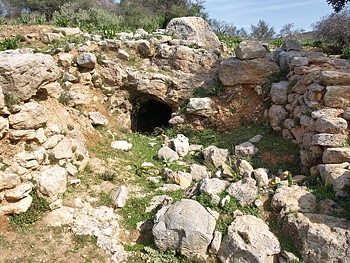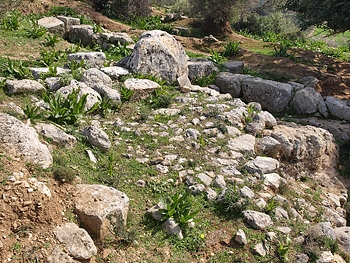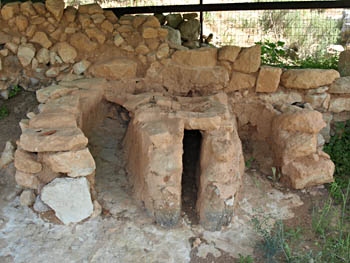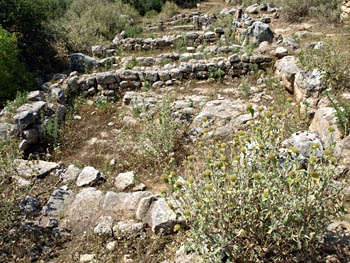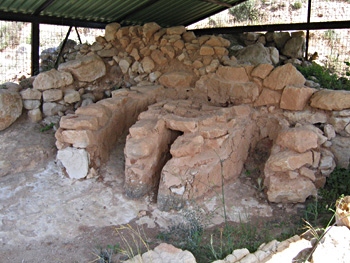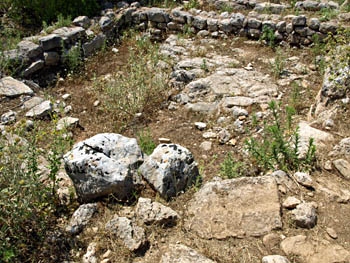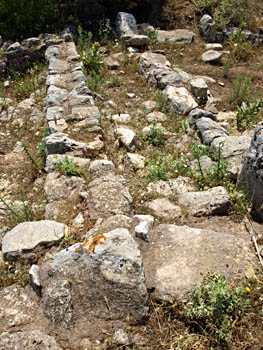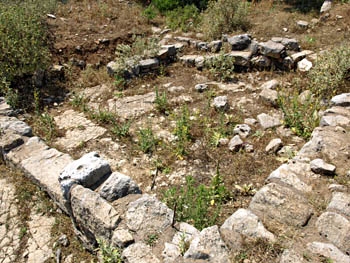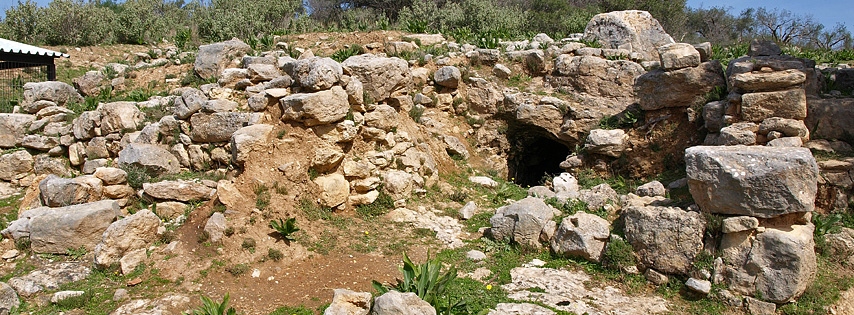
The Minoan settlement
A short distance from the road between Stylos and Aptera, on the northeast slope of a hill, part of a significant Minoan settlement, most probably associated with the LM III tholos tomb nearby, was excavated. It is thought that it may be the site of Minoan Aptera, known from Linear B tablets by the name a-pa-ta-wa. The settlement seems to have been occupied through the Minoan period until its abandonment in Late Minoan IIIC (1190-1070BCE) though the building that was excavated dated from LM III.
On one side was a wall 11 metres long, preserved to a height of 1.30 metres. A number of other walls were also uncovered but the layout of the building was not clear. Inside the building a small cave had been incorporated. The cave was 1.50 m deep and l.60 m wide and the entrance measures 1m high by 0.75 m wide. The cave had been enlarged by carving and levelling the natural rock at the sides. In front of the entrance a rectangular pit had been carved out with shallow steps carved inside the pit. At the highest point, a channel cut into the rock and covered with a series of thin paving bricks led to the cave which it seems served as a reservoir. In the building's second phase the the cave had been put out of use. The entrance to the cave and the area in front of it was blocked up. Inside the cave a number of grinding stones were found.
Above the cave two floor levels were identified, paved with stones and extending to a length of 4.60 metres. The older floor had a round, stone pillar base. The pillar would have been made of wood. On one side of the building a window was identified with one upright preserved to a height of half a metre. Also found on the building was a mason's mark in the form of a trident.
Among the ceramic finds were sherds of domestic pottery such as tripod vessels as well as sherds of pithoi, long-necked goblets, obsidian blades, grindstones, loomweights, spindle whorls and other items.
In 1972 another building containing an oval room and a triangular hallway was discovered between the tholos tomb and the Minoan settlement. The oval room had a north-south orientation and measured 7.60 metres by 3 metres and was defined by a stout, curvilinear wall up to one metre thick made up of two separate walls of orthostat-like walls with the interior filled in. The wall, which is preserved to a height of 0.70 m at its highest point, had been destroyed on the eastern side.
The entrance to the room was from the narrow south side, where a single theshold stone 0.80m wide preserving traces of the mortar of the doorway was framed by two doorjambs reaching a height of 0.85 m. In front of the doorway was a triangular antechamber measuring 3.80m by 2.60m and with an entrance, also 0.80m wide in the middle of the east side. In the southwest corner of the antechamber a low built bench was found.
The floor of the oval room and the antechamber slopes gently from north to south and was formed by the natural soft rock being roughly levelled. A few sherds from the LM III period were found, including pieces of a pithos with a rope decoration and also sherds from the Byzantine period and possibly later. The chronology and use of the room are not clear, in part due to its highly unusual shape. This raised doubts in the minds of the excavators as to whether it was a house, a place of worship or whether it was used for some social purpose.
The LM IIIB kiln
Connecting to the south wall of the large building but nevertheless outside it, a circular ceramics kiln dating to LM IIIB was discovered in 1971. It is the only kiln from this period known in western Crete. South of the kiln and the building, the hill slopes away abruptly for a short distance. Here various other buildings of the settlement were found. The physical erosion here caused the destruction of the south section of the kiln where the fire would have been kindled.
The kiln was found devoid of vessels or sherds. It has the shape of an irregular circle and it is preserved to a height of 0.70 m. It has an external diameter of 2.30 metres. The surrounding wall, about half a metre thick, is preserved mainly on the west side while the north section, which touches the adjacent building, aligns with that wall and loses its circular form at this point. Inside the kiln, created by two thin partitions, there are three narrow elongated channels 1.30 metres long of which the central channel is straight but the two side ones appear slightly curved following the general shape of the kiln. These channels are just over half a metre high and were housed in a clay and stone construction. At intervals along the top of their length there are holes about 0.20 m wide. The housing of the central channel is well preserved and contains three holes. The other two are less well preserved. The one on the left has one hole remaining, the one on the right none.
There would have been a grate above these channels on which the vessels for firing would have been placed. The grate rested on the perimeter wall of the kiln. This may have been a permanent grate or it may have been made, using broken pottery and clay, each time the kiln was used. The potter would have kindled his fire south of the kiln and introduced burning material into the three channels in the kiln from outside as needed in order to raise the temperature to the level necessary for firing the pots. Minoans did not favour charcoal as the source of heat so as the burning material was consumed or turned to charcoal it would be removed and replaced with fresh burning material. The heat would rise through the holes into the chamber and out through a hole in the roof. This updraught would have aided circulation of the hot gases through the kiln. It is not known what the top of the kiln looked like. It is likely that either the kiln top was dismantled after each firing and rebuilt again the next time a firing was planned or more likely the roof was removed and vessels inserted and removed from above. The objects for firing would have been relatively small vessels and small pithoi given the available space.
The 7th century AD building
At the end of the 1990s a large building from the 7th century AD was discovered to the west of the Minoan buildings. It remained in use for about two centuries. Four rooms, built one next to the other with a common west wall, were uncovered. Between two of the rooms there had been a staircase leading to an upper floor.
The first picture below shows the kiln. The following pictures show the four rooms of the 7th century AD house photographed from the west,
starting with the most northerly room followed by the site of the staircase and then the three remaining rooms.
Driving from Stylos, a difficult to spot brown Archaeological Department sign on your right marks the entrance to the site. On entering the site you need to double back inside the fence until you see a path leading uphill on your right. At the top of the path you should be able to see a wire enclosure with a corrugated iron roof which protects the kiln. The Minoan ruins are behind and to the right of the kiln. To see the 7th century AD house continue along the path for some 300-400 metres beyond the kiln. From there the views of the Stylos plain and the White Mountains are spectacular.

